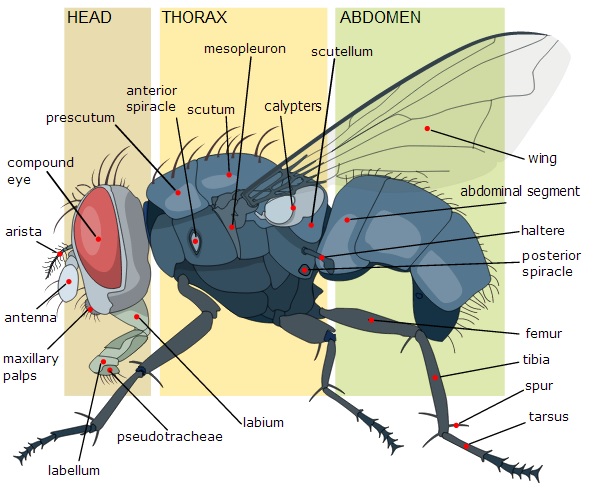Insects are invertebrates which have an external and internal anatomy which is structured and functions widely differently from vertebrate species. Understanding an insect’s anatomy and physiology allows us to realize how insects have evolved to live on the planet and teaches us how to control insect problems which may arise.
The external anatomy of an insect is very distinct. Insects have a hard external covering, called an exoskeleton, which is composed of plates and this layer also possesses flexibility due to the sutures they have connecting the plates (these are like joints). The exoskeleton maintains a permanent size, not growing throughout an insect’s life. However, insect’s molt multiple times as they grow. In the process of molting insect’s shed their current exoskeleton so that a new layer underneath can emerge. It is important to note that vertebrates do not have exoskeletons, but have endoskeletons instead.
An insect’s exoskeleton bears multiple advantages which include: protection from injuries, preventing desiccation, allowing chemicals to flow into and out of the body, allowing for internal muscle attachments and support for the insect’s body weight. Furthermore, an insect’s exoskeleton is segmented into three distinctive regions which include: the head, thorax and abdomen.

Figure 1. This diagram presents the three major body divisions which insects possess. Each of these three regions has been broken down further to illustrate the parts which they are composed of. This image has been taken from http://commons.wikimedia.org/wiki/File:Housefly_anatomy-key-en.svg.
In terms of their physiology, insects possess a circulatory system, respiratory system, digestive system, nervous system, endocrine system, muscular system and reproductive system. Just as in humans, the nervous system of an insect is divided into the central and periphery nervous systems.
In terms of respiration, insects do not have lungs, but rather have an internal tracheal system comprised of tubes and sacs. The tracheal system also contains spiracles through which air is taken in and the spiracles assist in minimizing the amount of water lost when oxygen is acquired. Furthermore, since insects carry a tracheal system delivering oxygen directly to their body tissues, their circulatory system does not need to carry oxygen. Thus, insects possess an open circulatory system.
Insects are an extremely diverse group of species considering that they are the most dominant life form on Earth. Thus, this discussion only begins to discuss the anatomy and physiology of insects as it is a rather expansive subject.
© BrainMass Inc. brainmass.com June 27, 2024, 12:58 pm ad1c9bdddf